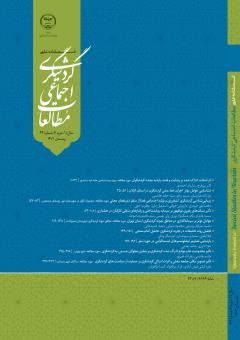Freedom, authenticity, intimacy and charm: Representation of travel influencers’ photos in Instagram
Subject Areas :
hoda davari
1
,
hamed bakhshi
2
*
![]()
1 - Ferdowsi University
2 - سازمان جهاد دانشگاهی خراسان رضوی- پژوهشکده گردشگری
Keywords: Tourism, Semiotics, Influencer, Instagram, Travel, Representation ,
Abstract :
Created on a social network basis, Instagram pages effectively contribute to shaping our mental perception regarding various topics. On the other hand, those Instagram pages dedicated to travel have highly been welcomed by viewers in recent years. Actually, the representations made by the relevant influences concerning the travel process, travel destination, and travel meaning construct some explicit and implicit meanings. Therefore, this study sought to identify the semantic system governing the popular Instagram pages of travel influencers. The conceptual framework of the study is based on John Fisk's semiotic approach and his social reality codes, including social reality, representational reality, and ideological reality. Social reality codes address physical characteristics such as speech, environment, and clothing. Moreover, representational reality codes deal with the sender's creative power, including framing, colors, companionship and substitution, and characterization. Finally, ideological reality codes examine the concept that gives coherence to such categories. The findings of the study indicated that naturalism, intimacy, liberation in social relations and individual lifestyle, availability and ease of travel, charm-seeking, desire for freedom, travel as a lifestyle, and responsible travel are the pivotal values represented by travel influencers at the level of ideological codes, representing such a special type of tourism that seeks changes in daily routines, acquisition of new experiences, the quest for authenticity, and returning to the true self. This travel style represents a conscious or non-conscious effort against the homogenization of the modern world and a kind of resistance against daily routines, rationalization, and social order.
احمدی، بابک. (1371). از نشانههای تصویری تا متن. تهران: مرکز.
آسابرگر، آرتور. (1379). نقد فرهنگی. ترجمه: حمیرا مشیرزاده. انتشارات باز
استوری، جان. (1386). مطالعات فرهنگی درباره فرهنگ عامه. ترجمه: حسین پاینده. تهران: آگه.
آلن، گراهام. (1385 ). رولان بارت. ترجمه: پیام یزدانجو. تهران: مركز
بهمنی، مهرزاد. (1392). نظرسنجی از شهروندان 11سال به بالا تهرانی درباره شبکههای اجتماعی و نحوه تعامل با آنها. مرکز تحقیقات سازمان صدا و سیما
پاینده، حسین. (1384). «هویت اجتماعی ایران». مجله فرهنگ و پژوهش، شماره 191 ، تهران.
دوسوسور، فردینان. (1382). دوره زبانشناسی عمومی. ترجمه: كوروش صفوی. تهران: هرمس.
راودراد، الف. و تقی زادگان، م. (1391). «سپیده یا الی؛ خوانش انتقادی فیلم درباره الی». فصلنامه مطالعات فرهنگی و ارتباطات، سال نهم، شماره 31.
راودراد، الف. و فرشباف، س. (1387). «مرگ و جامعه: تحلیل آثار بهمن فرمانآرا از منظر جامعه شناسی سینما». فصلنامه مطالعات فرهنگی و ارتباطات، سال پنجم، شماره 1.
سجودی، فرزان. (1398). نشانه شناسی کاربردی. تهران: علم.
کرس و ون لیون. (1395). خوانش تصاویر. ترجمه: سجاد کبگانی و فرزان سجودی. تهران: هنر نو.
گافمن، اروینگ. (1397). نمود خود در زندگی روزمره. ترجمه: مسعود کیان پور. تهران: مرکز.
گیرو، پییر. (1383). نشانه شناسی. ترجمه: محمد نبوی. تهران: آگاه.
فروغ زاده، سیمین و رضوی زاده، ندا. (1393). «گونه شناسی گردشگران شهری: کاربست مدل نهادی کوهن (مطالعه موردی: شهر مشهد)»، مجله برنامه ریزی و توسعه گردشگری، سال سوم، شماره9، [169و190].
فیسک، جان. (1384). نگاهی کوتاه به نظریهها و مکاتب ارتباطات. ترجمه: ناصر فرونچی. مشهد: کنکاش دانش.
فیسک، جان. (1381). فرهنگ و ایدئولوژی. ترجمة: مژگان برومند. فصلنامة ارغنون، شماره 09 : 1117,126
هال، استوارت. (1391). معنا، فرهنگ و زندگی اجتماعی. ترجمه: احمد گل محمدی. تهران: نشرنی.
محمد پور، احمد و ایمان، محمدتقی. (1387). «بازسازی معنایی پیامدهای تغییرات اقتصادی در منطقه اورامان تخت کردستان ایران: ارائه یک نظریه زمینهای»، فصلنامه رفاه اجتماعی، شماره 27، [191-213].
محمد پور، احمد. (1397). ضدروش. تهران: لوگوس.
نوربخش، یونس؛ کلانتری، عبدالحسین و فرهادی، احسان. (1398). «گردشگری بازتابی از زیست جهان شهری مدرن»، فصلنامه گردشگری شهری، دوره6، شماره4 ، صص95 تا110.
ون لون، یوست. (1391). تکنولوژی رسانهای از منظری انتقادی. ترجمه: احمد علیقلیبان. تهران: همشهری.
Ambani Baruah, Anali,2017, TRAVEL IMAGERY IN THE AGE OF INSTAGRAM: AN ETHNOGRAPHY OF TRAVEL INFLUENCERS AND THE “ONLINE TOURIST GAZE” , University of London,
Barthes, R. (1977b), Image, Music, Text, New York: Hill and Wang.
Bucholtz, M. & Hall, K. (2005). Identity and interaction: A sociocultural linguistic approach. Discourse Studies, 7(4-5), 585-614.
MIOTTI, TAYLOR. (2019). HOW TO BE AUTHENTIC: a visual social semiotic approach to travel photography on Instagram. Lund University. Master’s thesis.
Kress, G. & Van Leeuwen, T. (2001). Multimodal Discourse: The Modes and Media of Contemporary Communication. London: Arnold.
Coley, W. (2015). Why It Matters to Follow Back on Social Media - And How to Do It Right.politics.com.
Cohen, Kris R. (2005), “What Does the Photoblog Want? Media, Culture and Society, 27 (6), 883-901.
Fiske, John (1990) Introduction to communication studies, Routledge.
Giannotti, Cameron, 2021, How to Read Instagram Travel Influencer Photographs: A Semiotic Analysis of Space and Exclusivity in the Content of Instagram Travel Influencers, University of Alberta,
Nilsson, M. (2016). "First, let me take a selfie": Young adults' self-representation on Instagram (Master’s Thesis).
Kaplan, A. M., & Haenlein, M. (2010). Users of the world, unite! The challenges and opportunities of Social Media. Business Horizons, 53(1), 59-68.
Koles, B., & Nagy, P. (2012). Virtual customers behind avatars: The relationship between virtual identity and virtual consumption in second life. Journal of Theoretical and Applied Electronic Commerce Research, 7(2), 87-105
Wendt, B. (2014). The allure of the selfie: Instagram and the new self-portrait.Amsterdam: Institute of Network Cultures.

